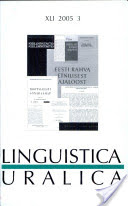Distances among Uralic and Other Northern Eurasian Languages
Distances among Uralic and Other Northern Eurasian Languages
Author(s): Ago Künnap, Rein TaageperaSubject(s): Language and Literature Studies
Published by: Teaduste Akadeemia Kirjastus
Keywords: Uralic; Altaic and Paleo-Siberian languages; structural linguistic features; commonalities between languages
Summary/Abstract: The present occurrence or non-occurrence of 46 structural features is analyzed in language groups ranging from Finnic to Eskimo-Aleut. Normalized measures of commonalities and distances between two languages are developed and used for graphical representations. The conventional Uralic and Altaic groupings emerge. So does a Paleo-Siberian concatenation (Yukaghir/Eskimo-Aleut/Chukotka-Kamchatkan/Yeniseian), more diffuse than even Uralic-Altaic jointly, but with some similarities to Samoyedic and Mordvin in the Uralic group. Within Uralic, four clusters emerge: Samoyedic, Mordvin/Saamic/ Finnic, Mari/Permic/Ob-Ugric, and most distant from the rest, Hungarian. Surprisingly, far from supplying a bridge to Altaic, Hungarian also appears as the Uralic language the most remote from Turkic and other Altaic. Turkic and Tungusic present almost as many commonalities with Uralic languages (except Hungarian) as with each other. Common origins cannot account for all these crisscrossing patterns; a continuum of contacts, selective migrations and participation in lingua franca areas must come into play. Extension of the existing set of structural features is urged, to include the distinguishing features of Basque, Indo-European, Semitic-Hamitic and Dravidian, as well as further Altaic and Paleo-Siberian features.
Journal: Linguistica Uralica
- Issue Year: XLI/2005
- Issue No: 3
- Page Range: 161-181
- Page Count: 21
- Language: English

